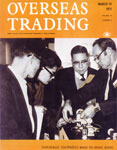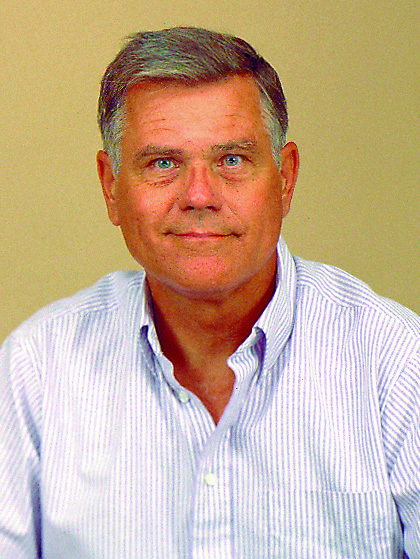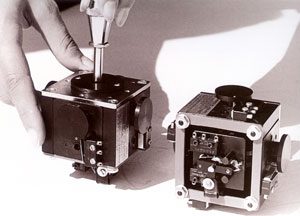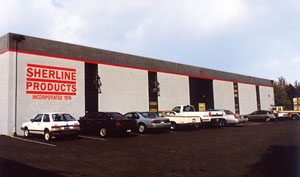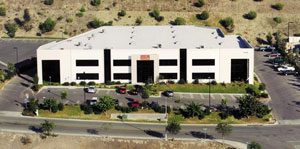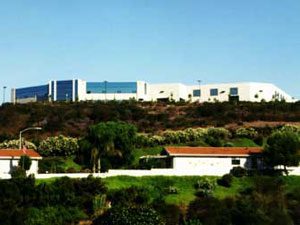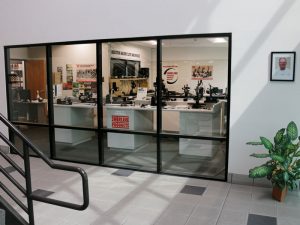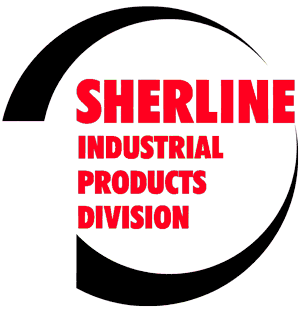Where We Came from and Where We’re Going.

Sherline’s Australian Roots
Though the Sherline product name was taken from the first manufacturer in Australia, Ron Sher, the designer of the original lathe and accessory line was an Australian engineer named Harold Clisby. He went to electrical engineer Ron Sher for help in the motor application for the lathe. Mr. Clisby’s clever use of extruded shapes, as well as many of his other concepts, have been carried over into the Sherline lathes produced today.
In a photo from the cover of Overseas Trading magazine from March 1971, inventor Harold Clisby of Australia shows an early version of the Clisby lathe.
First Model 1000 Lathe Originates “Down Under”
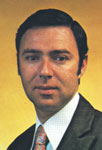
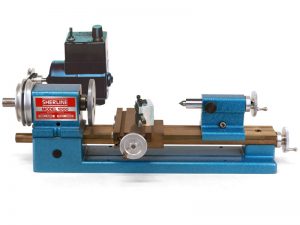
Ron Sher brought the lathe into production under the Sherline name in Australia. The original Sherline Model 1000 Lathe was designed in the late 1960s and built in Australia. The design of the machine and the idea of using aluminum extrusions to achieve a rigid machine at low cost was conceived by Australian inventor and engineer Harold Clisby. When Mr. Clisby decided to devote his energy to producing a line of air compressors, a Melbourne manufacturing engineer named Ron Sher put the lathe concept into production in 1971 under the Sherline name. The original design parameters included a rigid bed to avoid twisting and a low manufacturing cost. These goals were achieved through the clever use of extruded parts. Additional requirements in the design that have led to its continued success include:
- A variable-speed drive with a high-torque motor
- Attachments to allow it to be used as a Milling Machine
- Adjustable components such as gibs to allow accuracy to be maintained
- Easily replaceable parts in case of wear or damage
- General operational versatility
CLICK HERE to view plans for the original Sherline 3.5″ Model 1000 Lathe from Australia, 1971.
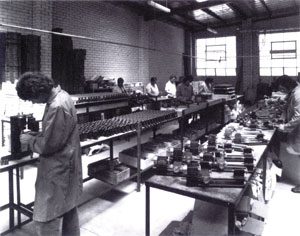
Ron Sher produced the lathe in his 10,000-square-foot facility. The company was called Ronald Sher Pty. Ltd., and he registered the trademark for the Sherline name and the business or trading name of Sherline Products. Trained as an electrical engineer with a specialty in series motor design for power tools, his design and marketing experience had been gained working with the first Australian manufacturer of power tools, Sher Power Tools. This business was started by his father and was eventually acquired by Skil Corp. With the assistance of the Australian Department of Overseas Trade (now Austrade), Sherline Products exhibited at various trade shows around the world, including the USA.
Joe Martin Negotiates to Distribute Sherline Lathes in the USA
Meanwhile, Joe Martin was working in the model radio control industry (Micro Avionics) and had used a Unimat miniature lathe to modify parts of an R/C model airplane joystick to make prototypes for a new joystick used to test control systems on NASA’s lunar lander. He liked the concept of a small lathe but felt the one he had used was not rigid or accurate enough. Later, while working at Kraft Systems, Joe was asked by the marketing department to evaluate the Sherline Model 1000 Lathe as a possible new product for Kraft to sell in the USA. Joe met with Ron Sher while he was traveling through the U.S. on his way to a trade show in Vancouver. At the time, Kraft Systems had just been sold, and the new management was not interested in taking on a new product. After his previous experience working on a miniature lathe with the joystick prototypes, Joe recognized the superior rigidity and accuracy of the Sherline design and felt there was a market for such a tool in the U.S. When Kraft Systems decided against taking it on, Joe put his money where his mouth was and left Kraft to form Martin Enterprises and distribute the Sherline lathe in the United States. Through Ron’s contacts in the power tool industry, Joe was able to get purchase commitments from Sears, Brookstone, and Jensen for catalog sales of the lathe.
Joe’s first experience with a small lathe involved extensive modifications to an R/C model airplane joystick for NASA. This joystick was used to test-land the lunar module prior to the first moon landing.
After importing the first 300 machines from Australia it was realized by both Ron and Joe that importing had become too costly to meet prices previously promised to the catalog companies. To bring down costs, it was agreed that Joe would incorporate Sherline Products in the USA in 1974 and assemble the lathe in the United States with Martin Enterprises producing the parts for Sherline Products, Inc.
U.S. Production Begins a New Era.
By the late 1970 ’s, Joe was producing the Model 4000 Lathe, a new 3-Jaw Chuck and a growing line of accessories. He continued to improve manufacturing methods to tighten up tolerances and expanded the line of accessories that now makes Sherline the most complete machine tool line in the world today—regardless of size! Being a toolmaker, he also recognized the need for a vertical milling machine and adapted a number of lathe components and designed new ones to produce a new machine—the model 5000 vertical mill.
The early contract with Sears Roebuck to sell the lathe under the Craftsman label helped get production numbers up. (Sears’ requirement for high-quality line drawings in their illustrated instruction manuals got me my first work with Sherline and set the standards for our instructions to this day.) In addition, a very favorable article by Popular Mechanics on the lathe helped boost early sales at a critical time.
In 1979, Sherline Products moved from several rented industrial spaces to its own 18,000-square-foot facility in San Marcos, California.
The single rental unit in 1973 soon expanded to two, three, four, five, and eventually six units before it was decided it was time for a full-time dedicated facility. In 1979 a new 18,000 square-foot factory was built. Originally operating as both a job shop and Sherline production plant, the facility is now dedicated completely to the production of Sherline products. The addition of many CNC (Computer Numeric Controlled) production machines has helped keep production costs down by both speeding up production and, at the same time, making more accurate parts. This means the Sherline tools of today are the best and most accurate we have ever produced.
Sherline’s third home was the 34,000-square-foot facility in Vista, California. In May 1998, the new building became home to the administration, sales, assembly, and shipping of the Sherline tool line. At the time of construction, production was also intended to be moved to this facility.
A New Factory in 2000 Means a More Streamlined Operation
In May 1998, Sherline assembly, sales, marketing, and administration moved into our new building in nearby Vista, California. After almost 20 years in the old building, there was just no room to grow. By the time this facility was completed, however, we had already grown beyond its capacity.
Land was purchased and planning for a new, even larger facility was begun in 1999. In June 2000, both previous facilities were combined into one. Built from the ground up based on our own specs, this new 66,000-square-foot facility now houses both the sales/marketing/assembly functions as well as the production equipment. More details on the new building and our production equipment can be found on our photo Factory Tour. The facility is located at 3235 Executive Ridge in Vista, CA.
A large showroom and demonstration area is on your right as you enter the new Sherline factory. Examples of every machine and accessory in the product line are available there for inspection.
New Products Take Sherline into other Markets
In addition to the ever-expanding line of miniature machine tools and accessories, Sherline has entered into other markets by producing laser engraved dials for full-size machine tools, hydraulic scales for the RV trailer market, and suspended scales for the farm and industrial market. We have also made things easier for our CNC partners and home users by designing and producing the parts to offer our machines in a “CNC-ready” configuration as well as offering our own complete CNC packages and CNC retrofits for existing Sherline machines. Another new development is a self-contained CNC rotary or linear controller to drive stepper motors, bridging the gap between hand control and stepper motor-driven movements without the need to purchase any separate computer or drivers.
Owner Joe Martin completed a book called Tabletop Machining in 1998. This book has sold even better than we had hoped and is now in its third printing. To augment our written tool and accessory instructions, we are also planning to produce a “how to” video on both the lathe and the mill to be available in the future. You can also count on us to continue to introduce new accessories to make your machining tasks go easier.
Sherline Adds Industrial Products Division
The newest line is directed to the industrial market. Sold under the Sherline Industrial Products Division, the line will feature machine slides and spindles that will help tooling designers produce economical production equipment. Sold only over the Internet, the Sherline Industrial Products Division offers components that can be assembled in “erector set fashion” to produce single-direction, multi-direction, and rotary movements. Industrial versions of our headstock are offered, which include a choice of spindle nose and style of the drive pulley. Visit the site for more details.
Sherline on the Web
This website has opened up the opportunity to provide information about Sherline Products to the whole world. We will continue to update and add to this site and try to make it one of the most informative around on the subject of miniature machining. We have also expanded our tool line to include industrial versions for use by tooling and machinery designers. We are glad you share this interest in our past, present, and future, and we look forward to serving your miniature machining needs.
